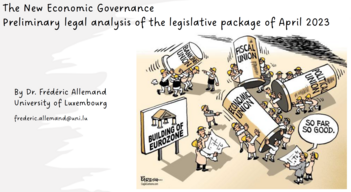The Reform of the Stability and Growth Pact: A legal perspective
With Frédéric Allemand, Research Fellow, Robert Schuman Institute, Université du Luxembourg
28/06/2023 (10:30-12:00)
ACV-CSC BIE, Rue Royale 45, 1000 Brussels
Languages: French, English
The reform of the Stability and Growth Pact (SGP) has the potential to profoundly influence Members States’ economic policies for the years to come. Together with one of the leading experts in the field of Economic and Monetary Union Law, we will take a closer look at the Commission’s proposal from a legal perspective. We will discuss the functioning of the reformed SGP, highlight its new features and examine in particular:
- To what extent does the new Stability and Growth Pact contribute to shaping the content of public spending, and in particular social spending?
- What mechanisms are planned to ensure the transparency of the process and the democratic accountability of those involved?
- What role is left for trade unions in the new European Semester?
Participation is free, registration is required.
The overview
On April 26, 2023, the European Commission published its proposal for reform of the Stability and Growth Pact, the European rules for mutual surveillance of member states' budgetary policies and coordination of their economic policies.
Among this set of rules, the budgetary rules are the best known. Their main aim is to ensure the budgetary stability of member states sharing the common currency. In particular, they require that budget deficits do not exceed 3% of GDP, and that public debt does not exceed 60% of GDP.
These rules have been harshly criticized, particularly since the 2009-2010 sovereign debt crisis. As the Commission itself noted in a 2020 report, they have not prevented member states' debts from rising and, in more than 13 out of 27 states, from exceeding the critical threshold of 60% of GDP. The pro-cyclical nature of the rules is also criticized: requiring member states to curb their spending in times of economic slowdown, they contribute to accentuating it. Finally, the complexity of the legislative edifice, its opacity, and ultimately the democratic legitimacy of the resulting "recommendations" are also singled out for criticism.
The new legislative package is designed to address these weaknesses.
The new pact makes little or no change to the content of the budgetary rules (the famous 60% and 3%). It does, however, aim to reconcile budgetary discipline with reform and public investment, placing greater emphasis on the medium term. It also seeks to simplify economic governance, improve national adherence and reinforce the enforcement of rules.
More concretely, the main new features are the following:
- Member States have a four-year period to put their public finances back on a sound trajectory.
- This four-year "adjustment period" can be extended by up to three additional years if member states commit to certain investments and reforms.
- Rather than being based on their budget balance (revenue minus expenditure), the indicator used to assess compliance with member states' budgetary commitments is their net public expenditure.
- The new package also provides for a stricter enforcement regime.
- Finally, the role of independent national budgetary institutions has been strengthened, which should reinforce national ownership.
The Parliament and Council must now discuss, amend and adopt these texts. The stated aim is to reach agreement before the end of the year.
An assessment by our President
The President highlighted shortly the work of EZA, uniting workers’ organizations, unions and educational institutions. Social dialogue is at the core of our actions, supported by the European Union in a special budget line.
The Reform of the Stability and Growth Pact is essential for the welfare and wellbeing of all European citizens.
An EU strategic anticipation is necessary, but also more difficult in the age of multiple crisis and permacrisis, rapid changes and evolving challenges, given that current levels of uncertainty, volatility, complexity, ambiguity and downside risks are likely to persist. We need foresight and forethinking, taking in account our new environment. Reconcile long-term thinking with short-term priorities. The reformed SGP must become more political, responsive, framed in a normative process of strategic thinking with more focus on policy options, multidisciplinary, considering the bigger picture and break silos.
The Six Pack, the Two Pack, the European Semester, all are strengthening the umbrella of the SGP, a binding diplomatic agreement among European member states, a set of fiscal rules to safeguard the stability and monetary union. Simply, member states cannot spend beyond their means (state deficit not exceeding 3% of GDP and national debt not exceeding 60% of GDP)
The SGP is often seen as a hard and blind policy, only looking to facts and figures and not considering the people and criticized for its strict fiscal rules. We have to acknowledge that without budget stability, there will be no room for growth, needed for investments in the economy, employment and social policy. The poorest and the most vulnerable will suffer the most of it.
The European Semester was steadily socialized with the new social scoreboard and now we must also socialize the SGP as well, with social citizenship, in a multi-level resource- based social rights framework. More social Europe, taking the European Pillar of Social Rights as a cornerstone, more convergence towards better working and living conditions and putting growing emphasis on social objectives and an enhanced role for the social actors, and specifically unions- as already enshrined in article 11 of the Treaty- in the cycle of the process, is needed.
Gives the proposed new SGP an answer to the challenges we face?
Will it be more risk- based than rules-based? Which balance between the preventive and corrective arm? Weather- and to which extent- the reform will take fiscal adjustments requirements for EU member states more lenient and flexible? Is there a more country- specific risk-based approach, requiring significant fiscal adjustments from member states with high debt sustainable risks and appropriate measures to be taken by debt- based excessive deficits? What about a greater differentiation between member- states? Will there come in place major strengthened enforcement mechanisms? Can better compliance with the rules be expected?
Anyway, the new SGP must go for fiscal rules that are fit for the challenges of this decade. ‘Sound public finances enable us to invest even more in the fight against climate change, to digitise our economy, to finance our inclusive European social model, and to make our economies more competitive’ ( Ursula von der Leyen).



